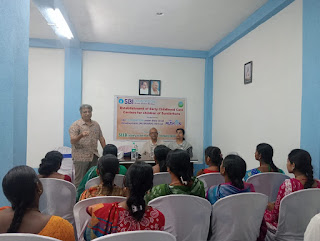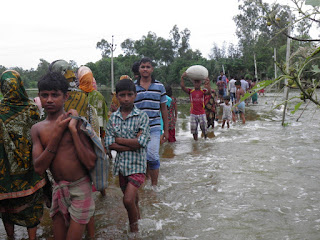Tucked between the confluence of the Ganges,
Brahmaputra, and Meghna rivers, the Sundarbans is one of the world’s largest
mangrove forests—a UNESCO World Heritage Site known for its biodiversity and
resilience. Yet behind this natural beauty lies a silent crisis: the vulnerable
state of early childhood care for thousands of children growing up in one of
India’s most ecologically sensitive and economically challenged regions.
Current situation
Early childhood care in the Sundarbans is shaped
by a complex interplay of geography, poverty, climate vulnerability, and social
factors. Children under six in this region face heightened risks due to natural
disasters, malnutrition, limited healthcare, and educational gaps.
The first five years of a child’s life are
critical. Brain development, emotional well-being, physical health, and social
skills are largely shaped during this time. For children in the Sundarbans—many
of whom face poverty, malnutrition, frequent displacement due to cyclones, and
limited access to healthcare—early interventions can be life-changing.
Ghoramara island, located approximately 92 km
south of Kolkata in the Sundarbans delta, is confronting severe environmental
challenges due to climate change. Once spanning about 26 square kilometers, the
island has diminished to roughly 6.7 square kilometers, primarily due to rapid
coastal erosion and rising sea levels. This drastic reduction has led to a
significant decrease in its population, from around 40,000 in the 1970s to
approximately 5,193 residents as per the 2011 Census. Population of children with
age 0-6 is 694 which makes up 13.36 % of total population of the island.
Insufficient healthcare infrastructure and geographical challenges due to
remoteness of the island adds to the plight of the children as the coastal area
keeps facing repeated climatic shocks such as cyclones and floods. Children are
mostly born without right antenatal care and are not sufficiently nourished
during the first few months of their lives to suffer from undernutrition and
related health problems. Preschool education here is usually handled by
Anganwadis, but quality and reach are not enough considering the present
scenario.
 |
| The Khashimara village school destroyed due to erosion |
Seasonal migration in fishing communities affects consistent preschool attendance. Infrastructure in many centres is vulnerable to monsoons and cyclones, affecting continuity and shortage of trained caregivers add fuel to this. Children also face trauma, displacement, and anxiety, impacting their psychosocial development. Dearth of safe play spaces and structured group activities impairs social-emotional learning in young
Children.
Parental care plays a pivotal role in early
childhood development, as a child's brain development, emotional health, and
social skills are greatly influenced by early relationships with caregivers. In
the Sundarbans, where families often rely on fishing, farming, and other
subsistence activities, parental care gets affected by various socio-economic
factors.
Challenges for Parents in the Sundarbans:
Economic pressures: Many parents in the Sundarbans face economic
challenges, which limits the time, energy, and resources they devote to
child-rearing.
Migration and displacement: Due to the cyclical nature of floods, storms, and
displacement, parents are usually unable to provide stable caregiving in times
of uncertainty.
Cultural and social norms: Traditional gender roles also leads to
disproportionate amount of caregiving responsibility on mothers, leaving them
overburdened, while also limiting fathers’ involvement in early childhood
development.
SEED, with financial support from SBI Foundation
under the project “Muskaan”, has set up two Early Childhood Care Centres (ECCC)
in Raypara village of Ghoramara and Radhakrishnapur village of Sagar Islands of
Sundarban. These centres aim to provide comprehensive support to children aged
0–6 years from marginalized and displaced families. Here the children will be
provided with-
Ø Daily nutritious meals and fortified supplements.
Ø Quarterly health screenings and micronutrient
distribution (vitamin A & D and iron) and deworming.
Ø Play-based pre-primary education focusing on
foundational literacy and numeracy.
Ø Parental workshops on child nutrition, early
learning, and positive caregiving.
This initiative targets at least 100 children, with a special emphasis on
supporting girls and children from SC, ST, and minority communities.
These children were selected followed by a
baseline survey and need assessment by the experts. Quarterly growth and
bi-annual health screenings (vision, hearing, dental & developmental
screenings) will be conducted to improve health status. The children will be
prepared for formal schooling with play-based pre-primary education process.
Program Goals:
Cognitive Development &
Emotional Resilience
Target: 50%
of children will benefit within one year.
Method:
Through structured play, storytelling, and guided interactions, the program
aims to foster both cognitive and emotional growth in the children.
Parental Education & Engagement
Target:
Educate 70% of caregivers/mothers.
Method:
Monthly workshops focusing on key areas: exclusive breastfeeding, child
nutrition, early learning, and positive caregiving.
Outcome: Enhance
maternal engagement by at least 15%.
Training and sensitization for parents,
especially mothers, will be provided on the importance of early childhood care which
can improve child development outcomes.
 |
| Training of the teachers |
Many areas in the Sundarbans lack access to
advanced medical facilities and trained healthcare professionals, making it
difficult for mothers to receive adequate prenatal, postnatal, and general
health care.
Under this “Muskaan” Project, SEED will provide
regular health checkups for mothers would be conducted along with psychological
counselling to monitor their physical and mental health. Addressing postpartum
depression (PPD) is crucial as it can affect both the mother and the baby.
Health professionals, such as community health workers would be trained and
involved in this programme to recognize signs of PPD and refer mothers for
psychological counselling or therapy. The stresses of motherhood, combined with
economic hardship and environmental concerns like frequent floods or cyclones
can contribute to mental health issues. These counselling sessions will create
safe spaces where mothers can talk about their mental health that can help to
reduce anxiety, depression, and stress. The mothers will also be taught the coping
strategies for dealing with the stress caused by environmental challenges, like
floods or loss of livelihood, which can help them manage their emotions better.
 |
| The joyful learning Centre |
Achievements of this project will be assessed
through a mid-term survey after one period after comparing these findings with
those of the baseline survey.
Early childhood care in the Sundarbans is both a
necessity and a challenge. The region's geographic isolation, frequent natural
disasters, and limited infrastructure significantly hinder access to quality
education, nutrition, and healthcare for young children. However, we are
optimistic that early investment in childhood development can break this cycle
of poverty and improve long-term outcomes for the communities. This collaborative
approach will ensure that children in the Sundarbans receive the nurturing care
and opportunities they need to thrive, laying a strong foundation for a
resilient and empowered future generation.






























